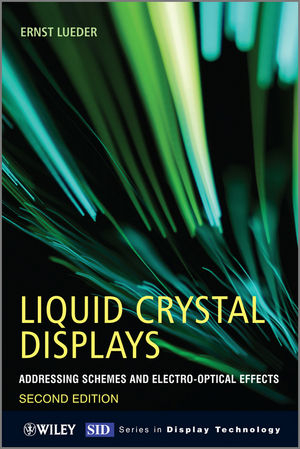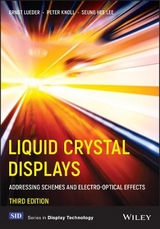
Liquid Crystal Displays
Wiley-Blackwell (Verlag)
978-0-470-74519-9 (ISBN)
- Titel erscheint in neuer Auflage
- Artikel merken
The second edition focuses on a variety of liquid crystal cellsand their electronic addressing, and outlines new developmentsincluding: * High performance VA cells, especially for TV, due to twosubpixels with excellent -correction also at obliqueviewing * Short optical response times in the range of 1 ms also forinter-gray transitions due to novel addressing waveforms * Fringe field switching for acceleration of rise and decay ofluminance eliminating frame memories * Reduction of motion blur by scanning backlights, high frequencyframes, edge enhancement and motion blur modeling * Very thin LCDs with power saving LED backlights exhibitingunmatched color purity and larger than NTSC color gamut * Printed layers on hydrophobic and hydrophilic areas replacingphotolithography Practicing electrical engineers, physicists, chemists anddisplay specialists will find this a valuable resource. Researcherswill appreciate the practical guidance given for the design ofimproved LCDs, whilst students are provided with a useful overviewof the field.
The Society for Information Display (SID) is an internationalsociety, which has the aim of encouraging the development of allaspects of the field of information display. Complementary to theaims of the society, the Wiley-SID series is intended to explainthe latest developments in information display technology at aprofessional level. The broad scope of the series addresses allfacets of information displays from technical aspects throughsystems and prototypes to standards and ergonomics
Dr Ernst Lueder (retired), Emeritus Professor, Department of Electrical Communications, University of Stuttgart, Germany Now retired, Ernst Lueder was Professor at the Department of Electrical Communications and Director of the Institute of Network and Systems Theory at Stuttgart University until 1999. He also headed a research laboratory for the fabrication of flat panel displays. Professor Lueder is a Fellow of SID, and is also an IEEE Fellow. He has been awarded the order of merit 1st Class of the Federal Republic of Germany. Since his retirement, he has written the first edition of Liquid Crystal Displays: Addressing Schemes and Electro-Optical Effects (Wiley, Mar 2001). He has also authored Bau Hybrider Mikroschaltungen (Springer-Verlag, 1977) and written over 200 papers on LCDs, network systems and theory and thin film sensors.
Foreword. Preface to the First Edition. Preface to the Second Edition. About the Author. 1 Introduction. 2 Liquid Crystal Materials and Liquid Crystal Cells. 2.1 Properties of Liquid Crystals. 2.2 The Operation of a Twisted Nematic LCD. 3 Electro-optic Effects in Untwisted Nematic LiquidCrystals. 3.1 The Planar and Harmonic Wave of Light. 3.2 Propagation of Polarized Light in Birefringent UntwistedNematic Liquid Crystal Cells. 4 Electro-optic Effects in Twisted Nematic LiquidCrystals. 4.1 The Propagation of Polarized Light in Twisted Nematic LiquidCrystal Cells. 4.2 The Various Types of TN Cells. 4.3 Electronically Controlled Birefringence for the Generationof Colour. 5 Descriptions of Polarization. 5.1 The Characterizations of Polarization. 5.2 A Differential Equation for the Propagation of PolarizedLight through Anisotropic Media. 5.3 Special Cases for Propagation of Light. 6 Propagation of Light with an Arbitrary Incident Anglethrough Anisotropic Media. 6.1 Basic Equations for the Propagation of Light. 6.2 Enhancement of the Performance of LC Cells. 6.3 Electro-optic Effects with Wide Viewing Angle. 6.4 Multidomain VA Cells, Especially for TV. 6.5 Polarizers with Increased Luminous Output. 6.6 Two Non-birefringent Foils. 7 Modified Nematic Liquid Crystal Displays. 7.1 Polymer Dispersed LCDs (PDLCDs). 7.2 Guest-Host Displays. 8 Bistable Liquid Crystal Displays. 8.1 Ferroelectric Liquid Crystal Displays (FLCDs). 8.2 Chiral Nematic Liquid Crystal Displays. 8.3 Bistable Nematic Liquid Crystal Displays. 9 Continuously Light Modulating FerroelectricDisplays. 9.1 Deformed Helix Ferroelectric Devices. 9.2 Antiferroelectric LCDs. 10 Addressing Schemes for Liquid Crystal Displays. 11 Direct Addressing. 12 Passive Matrix Addressing of TN Displays. 12.1 The Basic Addressing Scheme and the Law of Alt andPleshko. 12.2 Implementation of PM Addressing. 12.3 Multiple Line Addressing. 12.4 Two Frequency Driving of PMLCDs. 13 Passive Matrix Addressing of Bistable Displays. 13.1 Addressing of Ferroelectric LCDs. 13.2 Addressing of Chiral Nematic Liquid Crystal Displays. 14 Addressing of Liquid Crystal Displays with a-Si Thin FilmTransistors (a-Si-TFTs). 14.1 Properties of a-Si Thin Film Transistors. 14.2 Static Operation of TFTs in an LCD. 14.3 The Dynamics of Switching by TFTs. 14.4 Bias-Temperature Stress Test of TFTs. 14.5 Drivers for AMLCDs. 14.6 The Entire Addressing System. 14.7 Layouts of Pixels with TFT Switches. 14.8 Fabrication Processes of a-Si TFTs. 14.9 Addressing of VA Displays. 14.10 Motion Blur. 14.11 The Optical Response of a VA Cell. 14.12 Reduction of the Optical Response Time by a SpecialAddressing Waveform. 15 Addressing of LCDs with Poly Si-TFTs. 15.1 Fabrication Steps for Top-Gate and Bottom-Gate Poly-SiTFTs. 15.2 Laser Crystallization by Scanning or Large Area Anneal. 15.3 Lightly Doped Drains for Poly-Si TFTs. 15.4 The Kink Effect and its Suppression. 15.5 Circuits with Poly-Si TFTs. 16 Liquid Crystal on Silicon Displays. 16.1 Fabrication of LCOS with DRAM-Type Analog Addressing. 16.2 SRAM-Type Digital Addressing of LCOS. 16.3 Microdisplays Using LCOS Technology. 17 Addressing of Liquid Crystal Displays withMetal-Insulator-Metal Pixel Switches. 18 Addressing of LCDs with Two-Terminal Devices and Optical,Plasma, Laser and e-beam Techniques. 19 Components of LCD Cells. 19.1 Additive Colours Generated by Absorptive PhotosensitivePigmented Colour Filters. 19.2 Additive and Subtractive Colours Generated by ReflectiveDichroic Colour Filters. 19.3 Colour Generation by Three Stacked Displays. 19.4 LED Backlights. 19.5 Cell Assembly. 20 Projectors with Liquid Crystal Light Valves. 20.1 Single Transmissive Light Valve Systems. 20.2 Systems with Three Light Valves. 20.3 Projectors with Two LC Light Valves. 20.4 A Rear Projector with One or Three Light Valves. 20.5 A Projector with Three Optically Addressed LightValves. 21 Liquid Crystal Displays with Plastic Substrates. 21.1 Advantages of Plastic Substrates. 21.2 Plastic Substrates and their Properties. 21.3 Barrier Layers for Plastic Substrates. 21.4 Thermo-Mechanical Problems with Plastics. 21.5 Fabrication of TFTs and MIMs at low ProcessTemperatures. 21.6 Transfer of High Temerature Fabricated AMLCDs to aFlexible Substrate. 22 Printing of Layers for LC-Cells. 22.1 Printing Technologies. 22.2 Surface Properties for Printing. 22.3 Printing of Components for Displays. 22.4 Cell Building by Lamination. Appendix 1: Formats of Flat Panel Displays. Appendix 2: Optical Units of Displays. Appendix 3: Properties of Polarized Light. References. Index.
| Reihe/Serie | Wiley Series in Display Technology |
|---|---|
| Verlagsort | Hoboken |
| Sprache | englisch |
| Maße | 174 x 249 mm |
| Gewicht | 994 g |
| Themenwelt | Technik ► Elektrotechnik / Energietechnik |
| ISBN-10 | 0-470-74519-3 / 0470745193 |
| ISBN-13 | 978-0-470-74519-9 / 9780470745199 |
| Zustand | Neuware |
| Haben Sie eine Frage zum Produkt? |
aus dem Bereich



